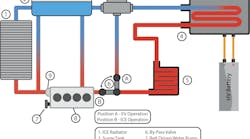Content brought to you by Motor Age. To subscribe, click here.
There is no question that the electric vehicle (EV) movement is in full swing. In 2022, Tesla sold 1.3 million units, an increase of 40 percent over the prior year. There is no doubt there is tremendous consumer demand for this segment of vehicles. So, does that mean that we will be servicing nothing but EV vehicles in the near future? Well, not exactly. The percentage of EV vehicles in comparison to the entire car parc is still very low. In fact, it is still less than 5 percent of the cars that are on the road today. Now, I am not suggesting we ignore EV vehicles. Rather, we need to take a strategic approach and prepare to service them.
We often hear that EV vehicles don’t require any maintenance. And yes, the internal combustion engines (ICE) have been an important role in service work. But the future for aftermarket service is still very bright. In this article, I would like to highlight some key services that carry over from a traditional vehicle and note some changes to services, if any exist.
If you ever had the opportunity to drive an EV, the first thing you will notice is a lack of sound coming from the now absent engine and exhaust. Instead, you now hear the slight hum of the electric motor, which allows you to focus on lots of other noises, vibrations, and harshness (NVH). NVH has been a growing service segment and will certainly continue to be with EV vehicles. NVH is nothing new, but this service category is going to continue and may even play an even more important role in the future.
Tires
They’re black, they’re round, and they are on every car, regardless of what is used to propel the vehicle. With that being said, you will often find tires on an EV vehicle that may have some marking that signifies it was manufactured for the EV market. Companies such as Goodyear, Bridgestone, and Michelin all have developed tires to reduce the amount of noise transmitted to the cabin compartment. They are doing this by adding foam and other sound-deadening materials to the inside of the tire. When an EV comes in for a tire repair, it will require a slightly different service than a traditional tire repair. Once the leak is identified, you will have to remove the section of foam -- if equipped -- from the tire. If the tire has a highly tacky adhesive, do not buff or use a cleaner on the spot. Use a scraper to remove any debris, then use a plug/patch combo to complete the repair. If the tire has a cured adhesive, you will use the traditional service procedure which will require buffing the area of the injury. Once the tire is repaired, you can either discard the piece of sound-deadening material, or you can use a little adhesive to reinstall the foam. In addition to the tire repair, an EV vehicle is going to wear tires nearly 20 percent faster than a traditional ICE vehicle. This is due to the weight and torque of these vehicles.
Brakes
We have all heard about how regeneration braking is going to make brakes last “forever,” and it may prolong the life of the pads. But we all know that a properly performing brake system is more than just pads and rotors. If the hydraulic braking system is not used often enough, the components that allow the caliper to slide might start to stick. Caliper slide service is going to play a big role in maintaining a hybrid. You may even see excessive rust buildup on the rotor, which will require reconditioning of the rotor to ensure the surface meets the correct roughness average (RA). In addition to the caliper slide service and brake rotor reconditioning, the braking system is still a hydraulic system that uses traditional brake fluid, and over time that brake fluid will degrade. The Motorist Assurance Program (MAP) supports testing brake fluid by either using a copper test strip or a PH test strip. Both of these methods allow you to quickly test the fluid to see if there is degradation. If you prefer copper test strips, then any test strip that shows more than 200 ppm requires a fluid exchange. If you use pH test strips, anything less than 6.5 indicates the brake fluid has become corrosive and will require a fluid exchange.
Fluids
Obviously, without an internal combustion engine there will not be engine oil to change. But that doesn’t mean there are no fluids that will need to be serviced. EVs still use coolant. This coolant is used to cool the battery, the inverter, and other associated parts. In addition to the EV powertrain components, there are coolant lines, chillers, pumps, and other items that relate to the cabin’s HVAC system. This complex system will require service as these components wear out. The coolant used is not the typical inorganic (IAT) or organic (OAT) type of coolant, because the electrical components will be submerged into the fluid. This requires a dielectric coolant.
In addition to coolant, there are transmission fluids, motor fluids, and greases that will all require service at some point.
Even with all the development of technology, the EV vehicle share of the car parc remains small and will take a very long time until we see a significant number of EV vehicles in our service bays. However, we must use this transition time to prepare and train whether it be as simple as how to properly rack an EV or more complex, like safely servicing high voltage components. All of this is critical if we want to remain a viable source of vehicle repair for consumers.

